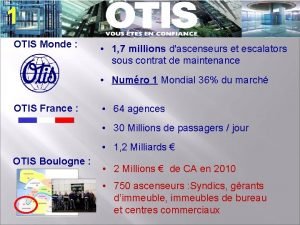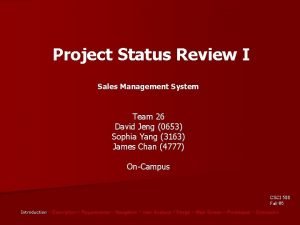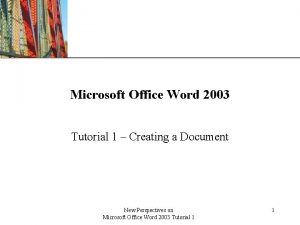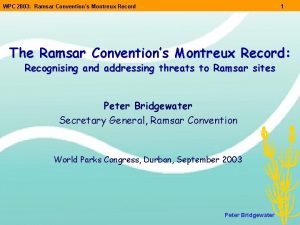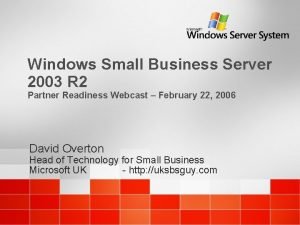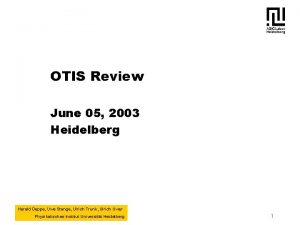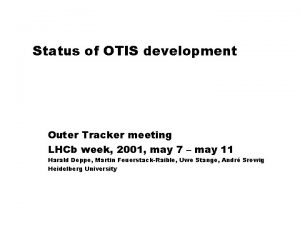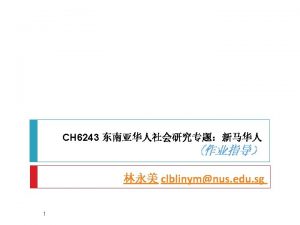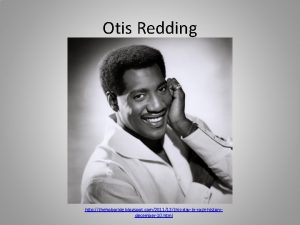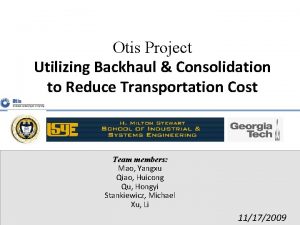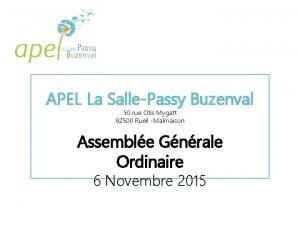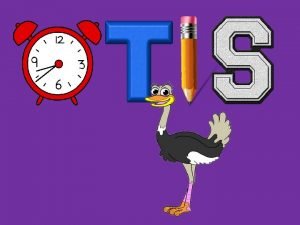Status of OTIS 1 0 OTIS Review 2003














- Slides: 14

Status of OTIS 1. 0 OTIS Review 2003, June 5 OTIS GROUP, Heidelberg University Harald Deppe, Uwe Stange, Ulrich Trunk, Ulrich Uwer Heidelberg University 1

OTIS TDC Chip Components: Ø 32 maskable channels (LVDS Input) Ø DLL, Hit. Register, Pre. Pipeline: 6 bit drift time encoding: 1 bit ↔ 0. 39 ns (req. resolut. < 1 ns) playback mode for testdata feed-in Ø Pipeline, Derandomizing Buffer: buffer length: 160 evts ↔ 4. 0 μs Ø Control Algorithm: Memory and trigger management, 2 read-out modes: 1, 2, 3 BX/evt Ø I 2 C Slow Control Interface: Programming, ASD bias setting Ø DAC: ASD-Chip bias Harald Deppe, Uwe Stange, Ulrich Trunk, Ulrich Uwer 2 Heidelberg University

OTIS TDC Ó 3. 250 OTIS-TDCs with 32 channels each Ó 4 OTIS TDCs are connected to one GOL (fast serializer chip) one fibre per 128 channels Ó Radiation hard layout 0. 25 µm CMOS Ó DLL fine time resolution 6 bit Ó Dual Ported Memory with 1. 2 Gb/s, 240 bit width (low power design) Ó Synchronous clock driven readout Harald Deppe, Uwe Stange, Ulrich Trunk, Ulrich Uwer 3 Heidelberg University

Delay Locked Loop Test chips for DLL, DLL with MUX and MEMORY : OTISDLL 1. 0 (Sept. 2000) OTISMEM 1. 0 (Feb. 2001) Ø 1 st DLL prototype, contains: Ø Delay chain with 32 stages 1 taps each Ø Mean delay per tap 25 ns/32 = 780 ps Ø Hit Register for only one channel Ø 2 nd DLL prototype, contains: Ø Delay chain with 32 stages 2 taps each Ø Mean delay per tap 25 ns/64 = 390 ps Ø Hit Register for only one channel with 64 bit multiplexed to 4 pads Harald Deppe, Uwe Stange, Ulrich Trunk, Ulrich Uwer 4 Heidelberg University

DLL Lock Time (2 nd prototype) Ø Lock Time is below 1µs DLL Out Clock In Phase Difference Control Voltage DLL Harald Deppe, Uwe Stange, Ulrich Trunk, Ulrich Uwer 5 Heidelberg University

DLL Temperature Range (2 nd prototype) Ø Measurement of Temperature Range Ø Control Voltage inside Dynamic Range for all tested Temperatures at 40 MHz Vctrl/m. V Dynamit Range Harald Deppe, Uwe Stange, Ulrich Trunk, Ulrich Uwer 6 Heidelberg University

Measurements on OTIS 1. 0 Ø Ø DLL Lock Range DLL Lock –Time Fine. Time Measurements Differential Non-Linearity Ø ALL limitations on the functionality of OTIS 1. 0 concerning Finetime and Hit. Bit encoding are due to parasitics. Harald Deppe, Uwe Stange, Ulrich Trunk, Ulrich Uwer 7 Heidelberg University

DLL Lock Time (OTIS 1. 0) DLL Out not. Reset Control Voltage Ø Lock Time is below 1µs Harald Deppe, Uwe Stange, Ulrich Trunk, Ulrich Uwer 8 Heidelberg University

DLL Lock Range (OTIS 1. 0) Ø Lock Range = 25… 60 MHz at 300 K Ø Spec is 30… 50 MHz at 300 K OK !!! Dynamic Range Ø Dynamic Range of Control Voltage 1. 4 V Harald Deppe, Uwe Stange, Ulrich Trunk, Ulrich Uwer 9 Heidelberg University

Fimetime Measurements (1) Ø Finetime Measurements for OTIS 1. 0 Harald Deppe, Uwe Stange, Ulrich Trunk, Ulrich Uwer 10 Heidelberg University

Finetime Measurements (2) Ø Finetime Measurements for an FIB patched OTIS 1. 0 Harald Deppe, Uwe Stange, Ulrich Trunk, Ulrich Uwer 11 Heidelberg University

Differential Non Linearity (1) Ø Differential Non-Linearity OTIS 1. 0 (preliminary): DNL = 1. 39 bin (= 0. 54 ns) Harald Deppe, Uwe Stange, Ulrich Trunk, Ulrich Uwer 12 Heidelberg University

Differential Non Linearity (2) Ø Differential Non-Linearity (corrected with Simulation results): DNL = 0. 634 bin (= 247. 3 ps) Harald Deppe, Uwe Stange, Ulrich Trunk, Ulrich Uwer 13 Heidelberg University

Summary Ø OTIS 1. 0 (TDC core) Ø Clock, Hit Signals differential Ø Lock Range 25. . . 60 MHz Ø Lock Time < 1 us Ø DNL 1. 39 Bins (preliminary measurements), 0. 64 Bins (corrected by simulation results), further investigation necessary!! Ø Chan. To Chan. Variation (measured for 1 st BX half) < 1 LSB Ø Known Bugs: Drift time encoding for 2 nd BX half and loss of Hit. Bit information! Well understood!!! Signal routing and driver strength have to be improved. A more relaxed timing will be chosen for Pre. Pipe-Components. Harald Deppe, Uwe Stange, Ulrich Trunk, Ulrich Uwer 14 Heidelberg University
 Con que amenaza virginia al fantasma
Con que amenaza virginia al fantasma My dog otis is not very bright
My dog otis is not very bright Otis ddl
Otis ddl Otis monde
Otis monde Mike shinoda 2010
Mike shinoda 2010 Otis tracker
Otis tracker Project status review
Project status review Chapter review motion part a vocabulary review answer key
Chapter review motion part a vocabulary review answer key Writ of certiorari ap gov example
Writ of certiorari ap gov example Nader amin-salehi
Nader amin-salehi Traditional and systematic review venn diagram
Traditional and systematic review venn diagram Narrative review vs systematic review
Narrative review vs systematic review Tutorial word 2003
Tutorial word 2003 Wpc 2003
Wpc 2003 Sbs 2003 cals
Sbs 2003 cals



